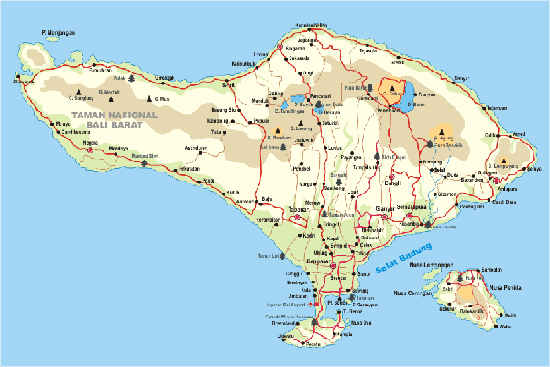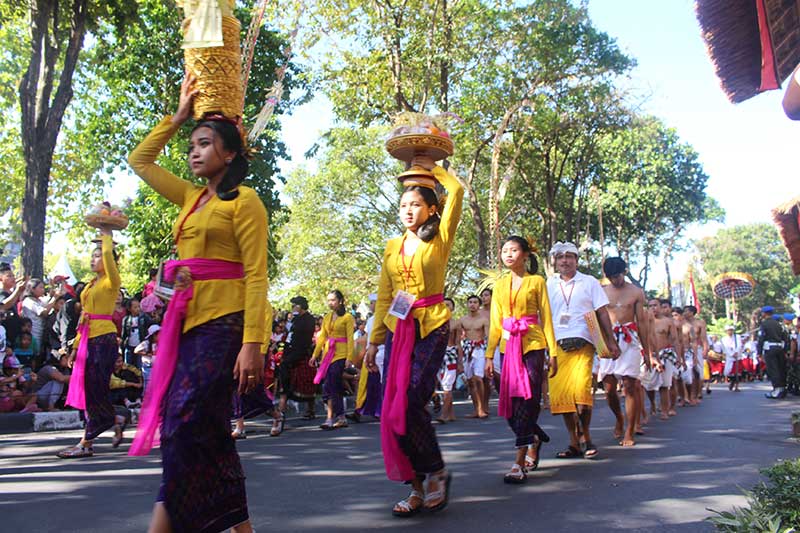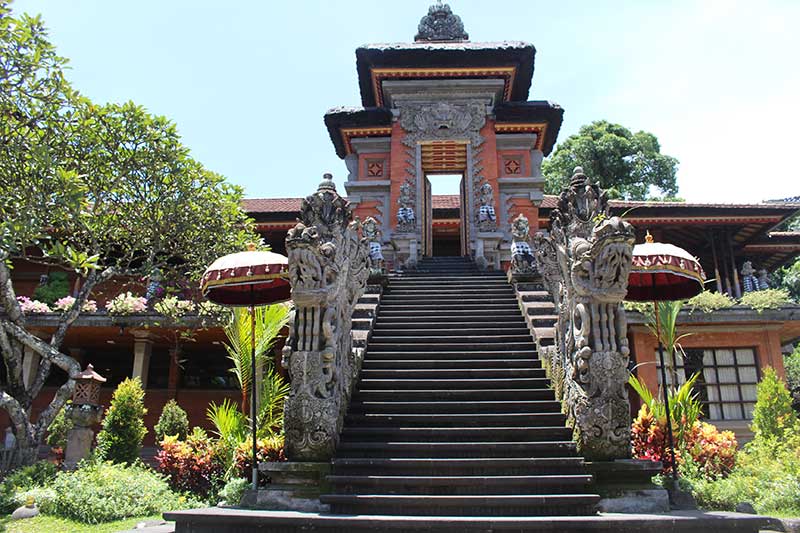Bali Indoensia Overview
The Indonesian archipelago stretches from the island of Sumatra
to Irian laya (Papua) and Bali is situated highly populated Java
and idyllic Lombok . Amongst the 13,700 Indonesians island Bali
is the only Hindu province and the rich blend of tradition and
culture has an incredible impact. Bali captures much of the soul
and identity of Indonesia yet it has evolved into a unique culture
of its own, making it a very special place.
Even though it is relatively small, approximately 5,000 square
kilometer in all, Bali boasts a whole range of different environments.
This compact landscape centers on a line of active volcanoes with
alluvial slopes that spill down to coastal plains. Tropical rainforests
fringe the mountains, eventually giving way to carefully cultivated
rice fields and crop growth. Further down on the plains, water
logged mangrove swamps lead to the ocean. A number of different
rivers and streams wind their way through a cross section of these
environments and down to the spectacular beaches. Bali enjoys
a consistently warm climate, which is particularly mild in the
dry season, and the mountains ensure there is a steady rainfall
to periodically cool the island down through the rainy season.

The mountainous regions maintain a refreshing temperature all
year round and can provide a great break from the heat and humidity
of the plains. The mountains are the focus of all daily activities
with holy Mount Agung as the great heavenward inspiration. All
villages, temples, family compounds, houses and furniture arrangements
are designed to face kaja, or toward the mountains. The seaward
direction kelod on the other hand, is considered to be less
sacred and at times impure.
Read also Bali Traditional House Compound Concept
Mountain slopes provide the ideal setting for the luminous terraced
rice fields. The Balinese have an ingenious irrigation system
controlled by a village organization called the subak who keep
these paddies well watered and the rich nutrients from the volcanic
ash ensure these fields are also well fertilized. Rice is the
staple food for all Balinese people and sampling the steamed rice
(nasi putih), fried rice (nasi goreng) or even yellow rice (nasi
kuning) is a must. Rice also has sacred significance and it is
offered back to the gods in the form of brightly colored cakes
or as a few grains sprinkled on a banana leaf.
Read also Bali Local Food, variety of local cuisine.
The rivers are a focus for rural village life, as they are a source
of water for both work and domestic activities. You'll often find
whole villages bathing in the rivers, washing their clothes, washing
their cars, fishing from them, or simply splashing around and
having a great time. Further down the river path, many of the
mud flats near the sea continue to be used by small family groups
for making salt, an essential condiment in Bali. At the edges
of the land the oceans are the source of holy water and the channel
for preparing the dead for their afterlife. There is still a great
fear of the sea so even though fishing and seaweed farming are
reasonably widespread and many activities revolve around the surrounding
ocean, it is treated with great respect.

Our knowledge of Bali during its prehistoric age is insufficiently
supplied as the historical records and artifacts are limited.
It is supposed that the first settlers of Bali arrived very early
in this prehistoric period although there are contrasting beliefs
as to their origin.
Some say that Austronesian (malayo-polynesian) migrants arrived
three to four thousand years ago while others believe that the
first settlers come from China around 2500 BC. The modern Balinese
language shows the reflection of the Proto Austronesian language
and can be used to trace back the origin of the Balinese. It is
also known that the descendents of the indigenous people who populated
the island were in Bali Aga, who practiced animism.
Prehistoric artifacts that were discovered include gravesites,
the sarcophagi stone and the Moon of Pejeng, a huge bronze kettledrum
that is thought to have supernatural powers and is today kept
in a temple in the village of Pejeng, Ginyar Regency. Others
were recently found in the Buleleng area. Some historical records
found from the time of 300 BC identified a more advanced and organized
agrarian society. Complex irrigation system supplied cascading
rice terraces in wet rice cultivation. As a result, rice was already
well and truly established as the major food commodity in Bali
and as its abundance and importance increased, so did its value.
Dewi Sri, the ancient rice goddess was revered then as she still
is today through cili figures given as offerings. Based on the
large produce of rice crops, communities became wealthier and
developed into more sophisticated kingdoms, each with ruling rajahs
or king.

One
of the most dramatic and enduring developments in the history
of Bali came about when a form of Hinduism, which had been introduced
to Java, was transported to and widely accepted in Bali in the
first century. This religion was in fact, a fascinating mix of
Siwa Hinduism and Mahayana Buddhism, both originally came from
India and brought to Indonesian by Indian traders. Artifacts found
include statues, bathing places, caves and temples. Inscriptions
dating back from around 800 AD were discovered on a stone pillar
near Sanur. This new religion hit the peak of its success in Java
came with the rise of the Majapahit Empire but these Majapahits
were eventually forced further east to Bali as Islam gained followers
throughout Sumatra and Java. Some Javanese shamanism was thrown
in en route and merged with Bali 's own form of animism.
The Balinese initially the arrival of the new religion and when
the Majapahits first invaded Bali in 1343, Gajah Mada, the prime
minister of Majapahit empire had an extremely tough opponent in
the Balinese king, Dalem Bedahulu. The king ruled from Pejeng,
now a simple village east of Ubud , and this was where much of
the action took place. The king was so stubborn in his resistance
that he became known by the Majapahits as Pighead. Stories made
beautiful with events relating to the kings incredible determination
and skill have survived, and he is now known literally, as king
with the pigs head and magical powers. Gajah Mada eventually defeated
the powerful king and has been considered a hero and great holy
man ever since. The new form of Balinese Hinduism is called Agama
Hindu Dharma, a blend of the elements from Hinduism and Buddhism
practiced in Japan, China and Korea as well as the Indian caste
system are now important components of the religion. An important
belief is that the elements of nature are influenced by spirits
that have been appeased. As such offerings (sajen) made from agricultural
products are offered to the spirits, It is believed that Gunung
Agung is the dwelling place of the gods and the ancestors, it
is revered as the Mother mountain and is highly sacred to the
Balinese. As water and volcanoes considered as the wrath of
the gods come from Gunung Agung, the mountain occupies the pole
of purity, Kaja. In contrast, the pole of impurity is the sea,
or Kelod. Balinese Hinduism revolves around the kaja kelod axis
and determines the spatial organization of the rituals architecture
and daily life. One sleeps, for example, with one's head in the
direction of the mountain.
Religion in Bali varies according to three principle Desa (place),
Kala (time) and Patra circumstances). Hinduism acknowledges five
pillars of
faith, they are a belief in the Supreme God, Brahman of Sang Hyang
Widhi Wasa, belief in the soul as the universal principle of life
and consciousness (Atma), belief in the fruition of one's deeds
(Karma phala), belief in the process of birth an death (Samsara)
and belief in ultimate release ( Moksa ). One of the consequences
of the principles of karma and samsara is the existence of the
caste system where an
individual inherits his status as a result of his past life. The
four castes in Bali are Brahmana , who deal with religion and
the holy texts, the Satria or rulers, the Wesia or merchants and
the Sudra the lower class, a social stratification initially based
on division of labor.
The main symbol of Balinese Hinduism or Agama Hindu Dharma is
the Swastika, or the wheel of the sun. The foundations of the
practices are to acquire knowledge of the epics and of theology
of ritual worship. The main purpose of life is to be released
from the wheel of reincarnation. Ones lot in present life is believed
to be a result of ones good or evil deeds accumulated from his
previous life or lives. Once the soul is released from the cycle
of reincarnation, he will become a god. The principle god are
Brahma the god of creation, Wisnu the god of providence and Siwa
the god of dissolution. These three move the world through an
unending process of birth balance and destruction. Man a microcosm
of the world, is subjected to the same process until he achieves
Moksa, blending into the cosmos and god. The cosmos and its movement
are symbolized by the swastika. Man should endeavor to maintain
the harmony of the whole system, hence the role of the ritual.
Only by adhering to the proper rules of behavior can the proper
balance be kept between the two sets of godly and demonic forces.
Balinese religion is known to the world through the richness of
its rituals. God and demon seem to be everywhere and the life
of the Balinese is therefore rich with abundant rituals. Balinese
rituals are ruled by a complex calendar system, a combination
of the Indian Saka calendar and the
Wuku calendar. The Saka year rules the agricultural cycle and
is divide into lunar months and fitted to the solar calendar by
the addition of an extra month, every thirtieth month. The full
moon and the dark moon are the most important ritual moments of
this calendar. The first day of the Saka year however usually
in March is the day of silence arnd profound importance throughout
Bali, a fasting day and a day for contemplation.
Read also Calender in Bali
The Wuku year consists of a cycle of 210 days divided into thirty
wuku weeks, each of which corresponds to a specific activity.
There is a week of weapons of plantations and one of animals.
There other types of weeks varying from one to ten days, each
having a name and number being auspicious or inauspicious. The
most important days in this system are Galungan and Kuningan.
Temples in Bali are simple walled open yards from which people
can communicate directly with their gods and ancestors. Gods and
ancestors normally “ visit” their human worshippers or descendants
during temple festivals ( Odalan ), and during the Galungan and
Kuningan holidays. They reside in miniature houses set in the
temple, called the pelinggih shrines, which are alight with effigies
of gold, coins or offerings. During the length of their stay the
gods and their companions are symbolically bathed, feted, put
to bed and entertained with dances and other shows. Meanwhile
members of the temple come and go over three or more days, with
offerings and to get their share of holy water sprinkled over
them and the offerings during the collective prayers.
Read also Colorful Ritual and Ceremony in Bali Island
European contact with Indonesian originated with Marco Polo's
visit in 1290 AD and after this time a demand for species and
Indonesia's other natural resources grew. Travelers from Spain
and Portugal then continued to return to Indonesia and visited
Bali for the next 200 years, although the difficulty of entering
and anchoring in Bali made it a less popular destination. By 1600
AD the Dutch East Indies Company had been set up in Java. Bali
was considered ”New Holland“ by a Dutch Admiral who was warmly
welcomed by Waturenggong, the King at the time. With the death
of this King, though, the seat of power in Klungkung diminished
in importance and independent rule was established by local rajas.
The British East India Company introduced some opportunities for
self-government to Bali in the early 1800s after Holland 's influence
decreased as a result of the Napoleonic wars. When the Dutch returned
to Indonesia and tried to gain sovereignty of Bali in the early
1840s, trouble flared. After sixty years, two important wars against
the Dutch i.e. Puputan (a battle to the last blood) Badung and
Puputan Jagaraga were popularly known as a mass suicide of Balinese
families finally ended what had developed into an ongoing - dipute.
Rather than giving in the Dutch, the rajahs and their families
chose to fight to the last blood or used ceremonial knives to
end their misery and make a proud statement.

Holland relented, and Bali survived the immediate threat of European
influence. The quiet period from the early to mid 1900s brought
a different type of western influence, though, with a sudden influx
of tourists. During this period, foreigners were already being
drawn to exotic beauty of the island and its people and culture.
Cruise ships made Bali a regular stopover, made Buleleng port
the main point to anchor and more and more people became intrigued
by this endearing paradise. Intellectuals and artists, priests
and princes, soldiers and artisans arrived in Bali with their
precious books and records, The Bali Island was flooded with creative
ideas and skills and the culture developed significantly. Two
major incidents interrupted this peaceful period. Firstly, the
Japanese invaded and occupied the island, as an attempt to over
run the Dutch government that had her central office on Java Island,
although the authentic Balinese culture could still be maintained.
Secondly, when the Dutch tried once more to exert their influence
after the Pacific War, Indonesia's President Sukarno declared
Independence in 1945. It look the Indonesia's War of Independence
a further four years before the Dutch finally accepted the authority
of the new government and even after that Indonesia remained unsettled.
Bali also suffered from individual disasters, a plague a period
of chronic food shortage and a volcanic eruption in 1963 that
made Surabaya have a dark day and Jakarta had rains of dust. Bali
only opened up to tourists again in the late 1960's , when the
new president recognized the value of the Island as a tourist
destination.
The Bali Beach Hotel, now Inna Grand Bali Beach Hotel, began
to be built early in the 1960s on President Sukarno's order, after
the building of hotel Indonesia in Jakarta had been completed
in 1926. Since then Bali has heavily promoted for its tourist
value and has also quite naturally acted as a magnet to the many
types of tourists who enjoy Bali. Artists, surfer, backpackers,
divers, shoppers, adventurers, scholars, writer and a whole range
of visitor now appreciate the many facets of the Balinese environment
and culture. Even on the brink of the 2l century Bali is proving
that the unique spiritual forces that have shaped the island will
continue to act as major determining influences well in to future.
Every time a small canang offering, laden with incense and colorful
flowers is laid on the ground, every time a chisel strikes soft
wood and carves out the features on a mythological creature, every
time a young baby touches the ground for the first time or ashes
offered to the seas, evidence of Bali's living traditions are
of her passion for an authentic existence. As a visitor it is
difficult not to be drawn in to the inherent magic of a place
where the people and the land interact so closely, where the people
draw so much meaning from the land and spirits. You can see this
magic and the long processions of flower and fruit- laden villagers
on their way to the temples or in the glittering dancers acting
out an ancient Hindu story. You can hear it in the lively clashed
and clangs of the gamelan orchestra or the quiet whispers of continually
offered prayers.
The countless sacred and secular dance, beautiful Bali
textiles and the wayang style of painting are among some of the
elements of the hearts of visitors. Whilst in Bali you may choose
to participate in this magic by visiting one of the numerous temples
with ancient Hindu symbols carved in huge slab of stone. You may
be lucky enough to observe a temple festival or public cremation.
Take the opportunity to see the graceful welcoming dance in which
young girls tilt their heads and move rhythmically to the gamelan
beat, sharing their flower offering with all. The Kecak Dance,
a hypnotic chant performed by score of men circled around a large
coconut oil lamp where scenes from the Ramayana are re-enacted.
Another must see is the Legong dance, which includes a series
of different dance scenes and styles. The more adventurous can
go trekking, for wheel driving, white water rafting and ride elephants
or even camel, diving, water sport. There is nothing quite as
exhilarating and spectacular as rushing down a river canyon or
trekking through thick matted forest. It is always possible to
feel some of that tribal Balinese magic when you venture out into
the wilderness of Bali .
There are also ample opportunities to ride the most exciting
surf in this part of the world, take leisurely walks in peaceful
jungles, go diving shop, trek volcanoes and enjoy a wide range
of delicious food. Eating and drinking should definitely be an
unforgettable experience in Bali. The seas around the island
are abundant with marine life, many of which end up in the kitchens
of restaurants. Fertile soils, bright sunshine and heavy rainfall
coupled with abundant water from mountain springs have allowed
rice, vegetables, fruits and many other crops to grow. This cornucopia
of ingredients allows a great variety of dishes to be prepared.
Wherever you are and whatever you choose to do, enjoy the warm
smiles and open embrace of a people who appreciate their whole
way of life and would love to share some of its magic with you
. The traditional prayer position of the hands and bow from the
heart are welcoming gesture designed to recognize and honor your
soul. If you experience but a small taste of this passion your
own lives will be enriched and if you also give something in return,
in the way of respecting these people and their culture and supporting
them as they find their way into the future, the benefits will
be mutual.
Let's visit Bali Island, will be serving you with our professional team work for your memorable holiday.
Bali Best Quote
Why rent a car in Bali with us?
Bali Island as one of the most famous tourist destinations in the world attracts visitors from all around the world to explore its uniqueness and beauty. Bali is well served by many modes of transport. Many hotels have a transportation desk offering a variety of transportation services, and tours, usually at higher prices. In the tourist destination, there are many transport services touts and vying for your attention. Rent Car Bali.net offer you reasonable transportation and rental car services with excellent services. We offer you:
- Bali Car Rental Self drive with a wide range of well-maintained fleet
- Rent a car with a Bali tour driver
- Bali car charter, price already included car, Bali tour driver, and petrol. Our tour driver will be happy to drive for you as per your own itinerary on Bali Island.
Don't waste your time, let's plan your holiday trip to Bali, we are ready to serve you. Your satisfaction is our priority. For more information please feel free to Contact Us.
- Hotline local number: 085737187321 and overseas number: 62 85737187321
- WhatsApp: 6285737187321
- Instagram: nyomanrentcarbali














